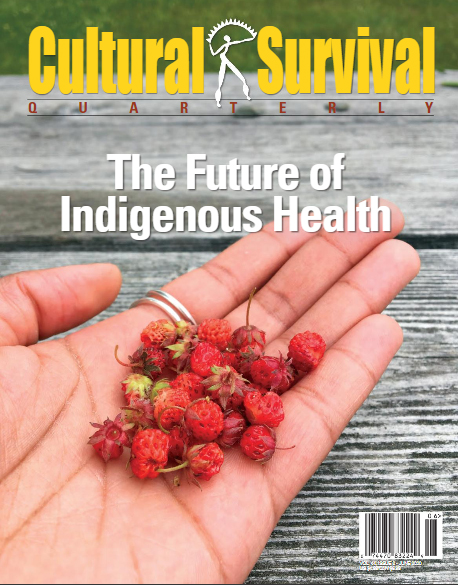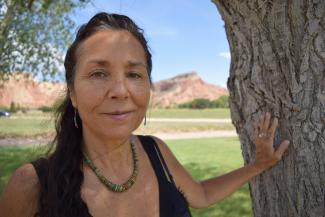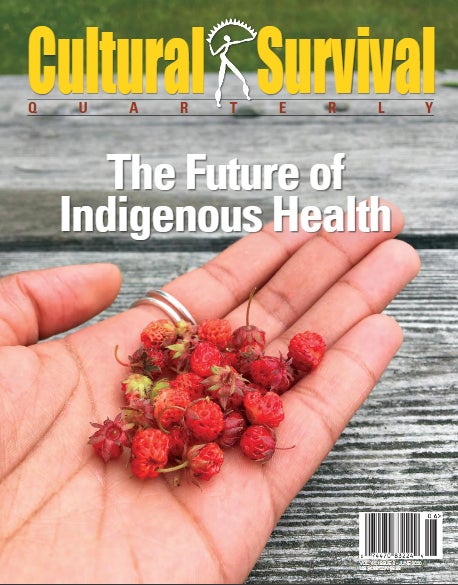Voice, Choice, and Power: Healing Intergenerational Trauma with Dr. Ruby Gibson
 15 Juli 2020
15 Juli 2020
intern
Mon, 06/01/2020 – 16:05
Dr. Ruby Gibson (Lakota, Ojibway, Mestiza), cofounder and executive director of Freedom Lodge, a nonprofit organization in Rapid City, South Dakota that provides historical and intergenerational trauma healing to Native American communities, shares her work on Somatic Archaeology© and its healing potential. She is the author of My Body, My Earth: The Practice of Somatic Archaeology.
Cultural Survival: What is Somatic Archaeology© and how can it improve the health of Indigenous Peoples through healing?
Ruby Gibson: Somatic Archaeology© is a recovery modality focused on the potential to excavate history in our body through body sensation, Photo by Jinji Thompson., and balancing the four worlds. We are a walking library and our body, much like the Earth, is full of information. In Somatic Archaeology© we say we’re digging within, excavating the source of our ailments. The five steps of Somatic Archaeology© are: I Notice; I Sense; I Feel; I Interpret; I Reconcile. We begin with noticing and follow body sensation through a bottom-up neurophysiological process until we reach step five, identifying the cause and effect of our symptoms—we call that reconciliation. Reconciliation reflects who am I when I’m free, or who am I when I’m liberated to live my life like I want, when I’m not carrying emotional burdens. That’s when transformation or healing happens. I have observed that the body follows the same five steps regardless of the elements or story one is carrying. Stories are typically based on the epigenetic memory patterns of our mothers, grandmothers, grandfathers, and parents.
In Lakota traditional ways, we generally use a medicine wheel as a way of understanding life and mapping out our experiences. If I can take a method and put it on the medicine wheel and it holds water, then I know it works, there is medicine to it. In our communities, we have 500-plus years of colonization, suffering, death, ethnocide, and disease to process, but when you use Somatic Archaeology©, it simplifies the process. Our biological and neurophysiological engagement allows us to start at the source and make our way to interpretation, as opposed to a westernized psychotherapeutic model that starts with analysis and then attempts to enforce what we believe on the body. We give the body a voice. Our primary model is “Voice, Choice, and Power.” Helping someone reclaim their power by giving their body a voice helps clients recognize they have choice.
CS: How has intergenerational trauma in Native communities affected health and well being?
RG: When we map our influences and look 7 generations behind us and 7 generations ahead of us, we find that we’re at the apex of 14 generations. If we choose, we can influence our actions and how our behaviors are going to affect the next seven generations. This position gives us a lot of power because our choices can impact our ancestors and lighten the load for our offspring. When you remain conscious about that, what you’re taking in, what you’re managing, and how you’re transforming it, you can utilize Somatic Archaeology© to transform your story—and then you actually become part of the solution in the human world and in all the four worlds (plant, mineral, animal, and human). We utilize the power from each of those four directions of life in order to put ourselves in the center of the circle. We become a point of transformation, and when we make that choice, there are so many possibilities—and life opens up in new ways.
CS: You have also coined the phrase, The Future of Native Wellness.™ What does that mean?
RG: I’ve spent a good portion of my life doing trauma recovery work, and sometimes it gets overwhelming and can be soul crushing. I reached a point of compassion fatigue, which I think is a crisis that every healer goes through at some point in their profession. I decided then that wellness was really the key. Black Elk, one of our Lakota elders who has crossed over, had a prophecy: “After seven generations pass, it’s the fulfillment of the prophecy and there’s a new prophecy.” It’s been seven generations, so what’s next? Wellness is really an extension of the eighth generation. People need hope, and they need to be able to find their way out of the cultural identity that associates us with suffering. Unless we change our perspective, we stay in this state of mind that has been carved out by nonIndigenous cultures. It’s time to get our power back. When we start looking at it from a place of power rather than a place of loss, that’s when we shift our focus to The Future of Native Wellness™.
.jpg)
Historical Trauma Master Class Trainers.
CS: Tell us about the Freedom Lodge and the work it does.
RG: Freedom Lodge was originally co-founded by me and a colleague of mine, Tulley Spotted Eagle Boy, a Canadian MicMac elder, after the government of Canada apologized to Indigenous Peoples. With government funding, Tulley established the Mother Earth Lodge and asked me to create a sister lodge in the United States, so I created Freedom Lodge. I started working with our youth, teaching Somatic Archaeology© to other therapists, and soon Freedom Lodge became an educational center. Five years ago I applied for a job with a nonprofit foundation as a program coordinator. The job was to positively impact Indigenous women and girls from Alaska to Mexico. They did not hire me for the position, but instead decided to fund me. This funding allowed Freedom Lodge to take Somatic Archaeology© out into the communities to support professional counselors and therapists. We provide our services free of charge to Tribal members. We’ve also developed the Historical Trauma Master Class™, and in each class we train about 30 professional counselors and therapists from various Tribes and teach Somatic Archaeology© . Graduates of this program who want to become trainers are taught to go out into their communities and start training people.
CS: What is your Healing the Sacred Womb Project?
RG: We have a high suicide rate amongst our youth, and I’ve spent time in many K-12 Tribal schools helping with suicide prevention. Suicide prevention often entails addressing the issue of sexual abuse. Many children were sexually assaulted in the boarding schools during the 1950’s-’70s and their children inherited the toxic imprints of the traumas. These schools were government funded and run by the churches with a specific goal of “killing the Indian in the child.” Murdered and missing Indigenous women are part of this legacy. Feeling like you don’t have value, or feeling that you only have value sexually, you begin to minimize your own life and your purpose. It’s one of the worst woundings for a child. We believe there’s a sacred law that says “no harm may come to the children.” Traditionally and historically, sexual abuse was never a problem in Native culture until European influence and invasion.
The Sacred Womb Project helps mothers and grandmothers to recover their own sacredness and innocence in their body, and consequently impacts their children and grandchildren. We work with shame; we work with honoring our bodies. We look at it this way: a woman is born with all the eggs she will ever have. Imagine you were an egg in your mother’s womb when she was in her mother’s womb. Our grandmother’s womb becomes our first experience of biological life. We’re all incubated in our maternal grandmother’s womb. If you were a seed in your mother’s womb when she was in her mother, then your daughter’s life began there also. We look at four generations of epigenetic inheritance through this model. This is how we remember how to protect ourselves, how we pass along knowledge, how we help to carry stories about who we are and our own traditions, and also the dangers that exist for us.
CS: What does the future of Indigenous health look like in your community?
RG: One component is ceremonial life, because it’s at the spiritual foundation of who we are. The second is language— being able to hear your ancestors and speak in your language allows the ancestors to make contact and defines the culture. Lakota is a present tense language. It’s about what’s happening now, not what happened in the past or what’s going to happen in the future. It’s very central to the moment. Traditional artwork, star blankets, bead work, all these components of a very rich culture and being able to reclaim those symbols and find beauty in traditions is part of wellness. If we are suffering so much that we end up drinking or getting high, we get distracted and forget who we are. Then those traditional things get lost.
Many factors lead to wellness and physical health, but comfort in your body is number one. The feeling of belonging to your culture and to your community, feeling like you have worth, that you hold an important place in family, all helps you feel connected. You can’t go back to the way you were, but you can replenish and remember. Your body has an amazing ability to not only recall traumatic events, but to recall positive events and historical knowledge that is layered inside of you. I learned an important moral through a dream—to always let the grandmothers drive. It was the most significant dream in my life because it helped me recognize that I wasn’t in charge. I also recognized a higher feminine power and I refer to them as the grandmothers. They guide my work and keep me humble. They keep bringing me gifts, they speak to me and tell me which way to go. I never travel alone and they’ve been at the core of the development of Somatic Archaeology©. This is an important part of my Wellness.
CS: Can these models be adapted to Indigenous communities around the world?
RG: That’s the dream. I’m a cultural healer. For me, healing trauma is fairly simple. It takes time, commitment, and courage to be willing to remember. What are we able to remember? A woman in one of my trainings had a visual impairment and had been unable to resolve it. After one session, that impairment went away and never came back. It’s because her body was willing and she trusted me. By being able to train a handful of people in a community to do individual work, people start feeling themselves transform in many ways. It changes the culture and the community. My heart beats strong with the thought of bringing our healing techniques into every Indigenous community in the world. It is financially viable, it’s fairly simple, and individuals can do the steps on their own. There is so much potential. When we take this work out into the world, it can reach every single person who it’s meant to reach. And that is in the hands of the grandmothers.
Top photo: Photo by Jinji Thompson.


